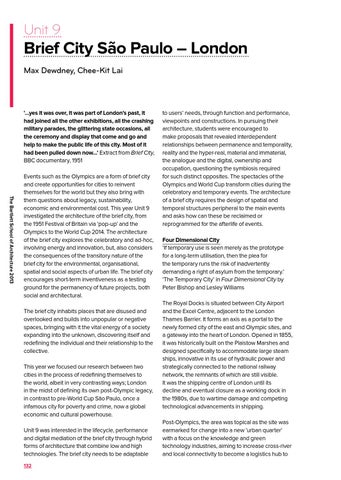Unit 9
Brief City São Paulo – London Max Dewdney, Chee-Kit Lai
‘…yes it was over, it was part of London’s past, it had joined all the other exhibitions, all the crashing military parades, the glittering state occasions, all the ceremony and display that come and go and help to make the public life of this city. Most of it had been pulled down now...’ Extract from Brief City, BBC documentary, 1951
The Bartlett School of Architecture 2013
Events such as the Olympics are a form of brief city and create opportunities for cities to reinvent themselves for the world but they also bring with them questions about legacy, sustainability, economic and environmental cost. This year Unit 9 investigated the architecture of the brief city, from the 1951 Festival of Britain via ‘pop-up’ and the Olympics to the World Cup 2014. The architecture of the brief city explores the celebratory and ad-hoc, involving energy and innovation, but, also considers the consequences of the transitory nature of the brief city for the environmental, organisational, spatial and social aspects of urban life. The brief city encourages short-term inventiveness as a testing ground for the permanency of future projects, both social and architectural. The brief city inhabits places that are disused and overlooked and builds into unpopular or negative spaces, bringing with it the vital energy of a society expanding into the unknown, discovering itself and redefining the individual and their relationship to the collective. This year we focused our research between two cities in the process of redefining themselves to the world, albeit in very contrasting ways; London in the midst of defining its own post-Olympic legacy, in contrast to pre-World Cup São Paulo, once a infamous city for poverty and crime, now a global economic and cultural powerhouse. Unit 9 was interested in the lifecycle, performance and digital mediation of the brief city through hybrid forms of architecture that combine low and high technologies. The brief city needs to be adaptable 132
to users’ needs, through function and performance, viewpoints and constructions. In pursuing their architecture, students were encouraged to make proposals that revealed interdependent relationships between permanence and temporality, reality and the hyper-real, material and immaterial, the analogue and the digital, ownership and occupation, questioning the symbiosis required for such distinct opposites. The spectacles of the Olympics and World Cup transform cities during the celebratory and temporary events. The architecture of a brief city requires the design of spatial and temporal structures peripheral to the main events and asks how can these be reclaimed or reprogrammed for the afterlife of events. Four Dimensional City ‘If temporary use is seen merely as the prototype for a long-term utilisation, then the plea for the temporary runs the risk of inadvertently demanding a right of asylum from the temporary.’ ‘The Temporary City’ in Four Dimensional City by Peter Bishop and Lesley Williams The Royal Docks is situated between City Airport and the Excel Centre, adjacent to the London Thames Barrier. It forms an axis as a portal to the newly formed city of the east and Olympic sites, and a gateway into the heart of London. Opened in 1855, it was historically built on the Plaistow Marshes and designed specifically to accommodate large steam ships, innovative in its use of hydraulic power and strategically connected to the national railway network, the remnants of which are still visible. It was the shipping centre of London until its decline and eventual closure as a working dock in the 1980s, due to wartime damage and competing technological advancements in shipping. Post-Olympics, the area was topical as the site was earmarked for change into a new ‘urban quarter’ with a focus on the knowledge and green technology industries, aiming to increase cross-river and local connectivity to become a logistics hub to
